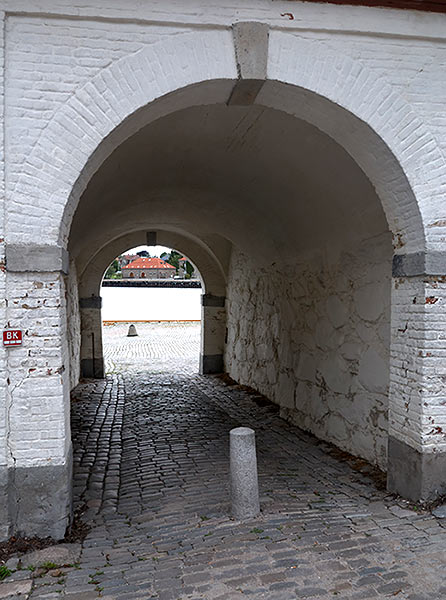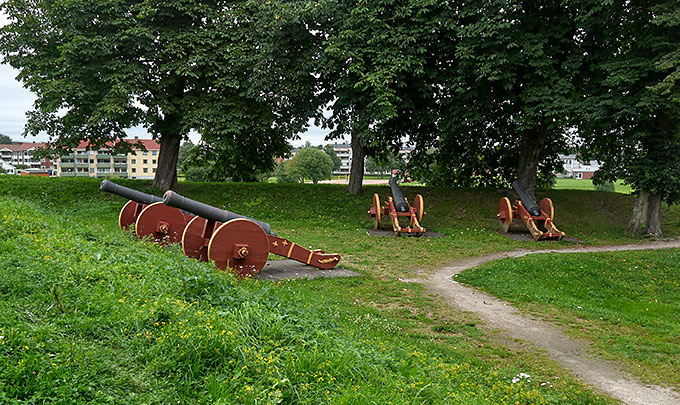Fredrikstad fortress
Fredrikstad was founded by the Danish king Frederik II (Norway was then part of Denmark) in 1567 at the mouth of the Glomma River on its eastern bank as a trading port for communication with Europe. Previously, the city of Sarpsborg, which lay a few kilometers upstream along the Glomma, played this role, until it was burned by the Swedes during the Seven Years' Northern War.
For a long time the city did not have walls, the first temporary fortifications were erected only in 1644-45 during Hannibal war with Sweden. In 1663-66, the fortifications were rebuilt under the project of Willem Coucheron and Johan von Cicignon in the form of the so-called. 'star' bastion fortress (old Danish system).
Over the next 60 years, three small forts were built around the fortress - Izergan, Kongsten and Cicignon and Fredrikstad became one of the most well-fortified cities in Norway.
In 1716, the fortress served as the naval base for the Danish-Norwegian fleet of Peter Tordenskold, famous for his raids against the Swedish fleet.
 Actually, Fredrikstad saw the warefare only once in 1814, when the fortress was attacked by the troops of the Swedish king Charles XIV Johan Bernadotte, a former Napoleonic marshal. As compensation for Finland lost by Sweden during the Napoleonic wars, Norway taken from Denmark was promised to him by the allies of anti-French coalition. In 1814, Denmark abandoned Norway in favor of Sweden by the Kiel Peace Treaty, but Norway, however, managed to declare independence, and then - new war begun ...
Actually, Fredrikstad saw the warefare only once in 1814, when the fortress was attacked by the troops of the Swedish king Charles XIV Johan Bernadotte, a former Napoleonic marshal. As compensation for Finland lost by Sweden during the Napoleonic wars, Norway taken from Denmark was promised to him by the allies of anti-French coalition. In 1814, Denmark abandoned Norway in favor of Sweden by the Kiel Peace Treaty, but Norway, however, managed to declare independence, and then - new war begun ...
On August 4, 1814, the commandant of Fredrikstad, Nils Hals, capitulated after several hours of artillery bombardment. The Swedes, however, in turn were repelled by the Norwegians on the way to Christiania (Oslo), after which peace negotiations began.
In 1735, a suburb arose on the western bank of the river just opposite the fortress, and, since its growth was not constrained by the city walls, the city center moved there. From the 1840s, the city became the main transshipment base for the Norwegian timber trade and began to grow rich rapidly. And in 1879 the railway connected Fredrikstad with the capital of Norway, Christiania. The city also had several large shipyards (the last one closed in 1988). By the way, Fredrikstad received city rights in 1838.
The fortress as military unit in Fredrikstad existed until 1903, after which it was decomisioned, but the military remained within old fortifications until 2002. Due to the fact that the development of the city took place on the western river bank, the city within the fortress retained its historical appearance.
Impressions
In 2017, Fredrikstad got the Norway's national award as the most attractive city to live in. Such bonuses are not given to just anyone, as you know. I would also give him such an award if I could. Therefore, the impressions of the visit are the most positive, despite the weather, short military history (for the fortress), lack of pocket money (for me) and the little time that I could devote to all this.
Everything here is very intimate, compact and reasonably arranged. Just like everything else in this country.
Land forts and fortress:
Bip Castle Gatchina Ivangorod Izborsk Kexholm Kirillov Monastery Koporye Novgorod Pechorskiy Monastery Peter&Paul Fortress Porkhov Pskov Schlisselburg Staraya Ladoga Tikhvin Vyborg Hameenlinna Hamina Kastelholm Kymenlinna Lappaenranta Raseborg Castle Savonlinna Tavetti Turku Visby Fredrikstadt Fredriksten Hegra Fort Hoytorp Fort Arensburg Narva Tallinn Antipatris Caesarea Jerusalem Latrun Fort Masada
Sea forts and fortresses:
Alexander Fort Ino Fort Krasnaya Gorka Fort Kronstadt: Kotlin isl. Kronstadt: North Forts Kronstadt: South Forts Trongsund Hanko Svartholm Sveaborg Marstrand Siaro Fort Vaxholm Oscarsborg
Artillery batteries and individual guns:
Coastal Artillery Hemso Fort
Fortified areas and defensive lines:
Karelian Fortified Area (KaUR) KrUR Leningrad Mannerheim Line Nevsky Bridgehead VT Line Harparskog Line Salpa Line Gothland
Russian
S e a r c h All news




